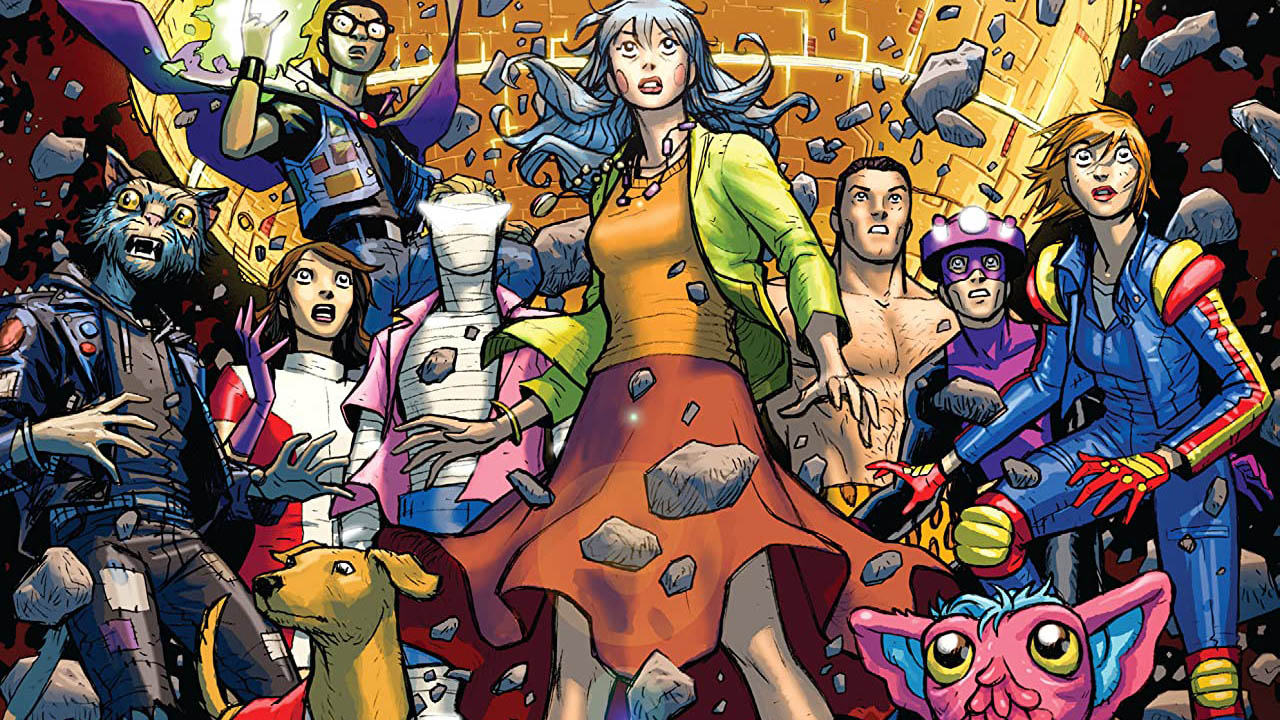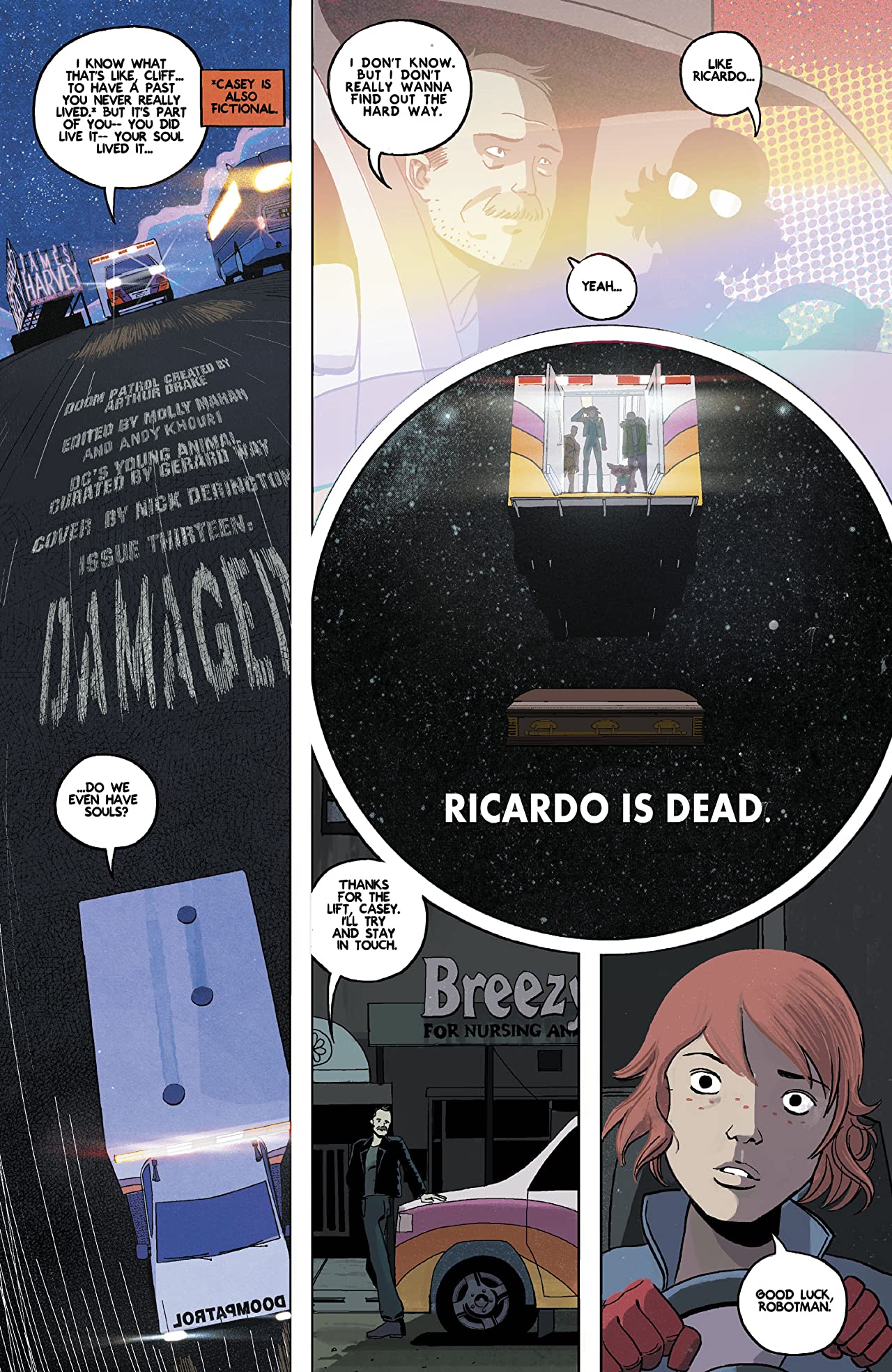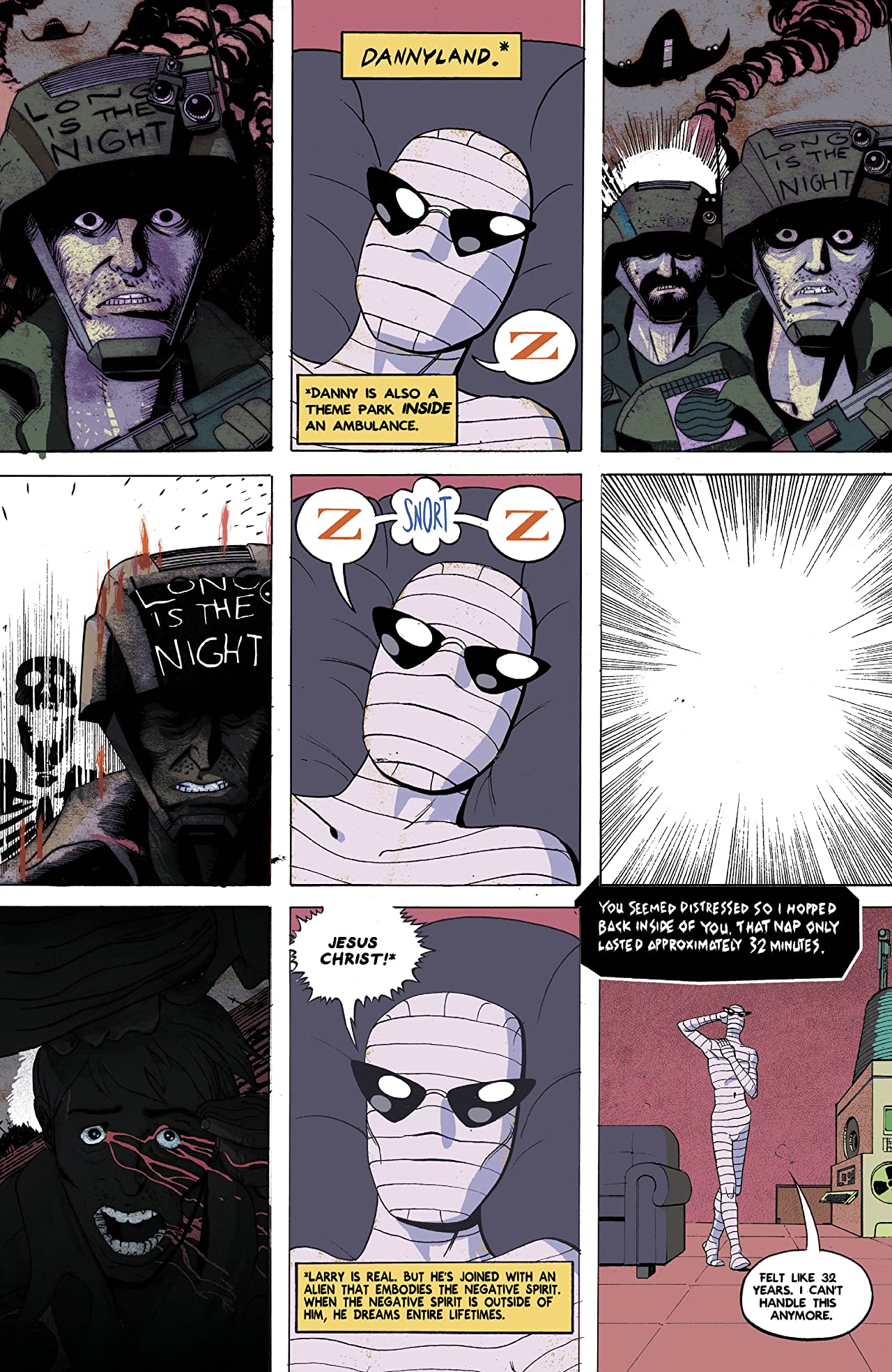Best Shots review - Doom Patrol: Weight of the Worlds "walks a fine line of being cosmic or preachy"
Gerard Way returns to Doom Patrol for Weight of the Worlds, but leans too much into the quirks

Doom Patrol: Weight of the Worlds builds upon what Gerard Way and his co-authors have built before, but it's also tied down by that same history.
First, a recap.
We last saw Gerard Way's incarnation of the Doom Patrol in 2018's The Milk Wars, a Young Animal (Way's imprint at DC) crossover with a 'Rebirth'-era Justice League of America team.
Written by Gerard Way, Jeremy Lambert, Steve Orlando, Becky Cloonan, and Michael Conrad
Art by James Harvey, Evan 'Doc' Shaner, Nick Pitarra, Becky Cloonan, Omar Francia, Nick Derington, Michael Allred, and Tamara Bonvillain
Lettering by James Harvey and Simon Bowland
Published by DC's Young Animal
'Rama Rating: 6 out of 10
Cliff Steele, called Robotman for some fairly obvious reasons, in the end, had a human, fleshy body for the first time in, like, forever. And Rita Farr, one of the founding members of the team who had actually remained dead for decades, slipped between the panels of continuity and found herself side-by-side with this latest version of the team. So that left the original team of Cliff Steele, Larry Trainor, and Rita Farr joining a couple of Grant Morrison's characters as well as a few Way/Nick Derington creations from the last series. This team included a woman with multiple personalities (each with their own unique power set), a circus-looking strong man, a cat who now had a humanoid body, a teenage wizard, and an ambulance driver who was once just a comic book character in a comic that only existed on a sentient street. Yeah, that may just be the most on-brand convocation of "the world's strangest heroes."
With Derington on art, Way redefined the Doom Patrol as metamodernist heroes, almost knowingly existing within the pages of comic books even as they exist somewhere between their traditional DC Universe roots and the Vertigo revisioning that's probably more familiar to most readers today.

Doom Patrol: Weight of the Worlds struggles with that status quo, trapped between tradition and re-interpretation. Way, joined on the writing by Jeremy Lambert, takes this large cast and tries to imagine what kind of wackiness they could get themselves into during an intergalactic road trip. At first, that includes taking on body shaming aliens and worlds that are getting a divorce from each other.
These aren't 'very special episodes' of the Doom Patrol but they walk a fine line of being cosmic or preachy. Maybe if this book had followed that formula, the Doom Patrol taking on a real-world issue in fantastic, imaginative, and optimistic ways, there really could have been something to this book. But those first few issues also have to clumsily deal with the ramifications of The Milk Wars, particularly Cliff and Rita and their new status quo. Rita is basically ignored, prancing in and out of scenes, almost but never quite dealing with her own possible body image issues.
Get the best comic news, insights, opinions, analysis and more!
That would have been a nice way to tie together the first story with the overall story. Even Cliff's story, of a human being dealing with an old, imperfect body, offers an opportunity to build themes through this book but Way and Lambert never seem to want to commit to that exploration for this book.
Rita seems to be brought back to life because, 'Hey, why not?' She was dead, now she isn't. That's cool, isn't it? And for Cliff, what does it mean to be human again after all this time? But wait! What if he was a robot? What would it mean for him to be a robot, like we haven't done that before? That's how the book treats these two characters, not as people to be explored as individuals but as comic characters who just exist as the characters. Cliff even gets a story page drawn by James Harvey that calls back to Frank Miller's The Dark Knight Returns but it doesn't do anything with it. It's an homage that adds absolutely nothing to Cliff or the Doom Patrol's story. Because to Way and Lambert, these characters don't exist as individuals or people; they exist as defined by their quirks.

Way's first run on these characters did an enjoyable job at mingling who these characters are with what they are. The ambulance driver Casey Brinke, Way and Derrington's best contribution to the Doom Patrol's legacy, had an outer struggle, trying to discover her true story, who she is, and where she came from. Way and Derrington balanced that with a confident and resourceful person who was able to adjust to the situation. She was the focus of that story and gave the creators the heart and soul of their version of the Doom Patrol.
In Weight of the Worlds, Casey is regulated largely to being just another member of the team. Without her presence here to anchor these stories, the book feels largely aimless and meandering. Part of that aimlessness is the ever-shifting creative teams. While Way and Lambert are involved in most of this book, they're joined on writing by Steve Orlando, Becky Cloonan, and Michael Conrad for a few chapters of the book.

Strangely, it is the chapters that have the additional writers on them which accomplish more. They feel more structured within themselves to tell a tight story. Orlando's contribution ties into what Way and Lambert are doing while the Cloonan/Conrad story accepts its Vertigo roots and pays direct tribute to Morrison and Richard Pace's Doom Patrol comics, showing a more personal relationship with these older stories and comic books.
On the artistic side, James Harvey kicks off the first two chapters but 'Doc' Shaner, Nick Pitarra, Cloonan, Omar Francia, Derington, and Michael Allred all contribute to the following chapters. This becomes a showcase of different art styles, each working with the chapter that they're given but it falls apart if this is supposed to be a single story. Shaner turns in a classic, noirish story with the Doom Patrol while Pitarra's artwork radiates weird energy vibes. Cloonan, in the chapter she co-wrote with Michae Conrad, delivers the most personal story, making a true connection with the Doom Patrol stories that have preceded hers. Francia's artwork is an odd blend of traditional comic work and a riff on old computer-generated shows like Reboot in a story that feels like it's been lost since around 2003. Derington and Allred show up for the last chapter, giving the book a return to the feeling of Way's original stab at this team but it also reads as a reminder of what this series could have been if Derington had been drawing it all along. With Tamra Bonvillain's bright and evocative coloring, this last issue is what the series should have been all along. That's not to say any of the art is bad; it's always a pleasure to see Pitarra and Cloonan. But what maybe worked as individual issues makes the collected reading experience jarring and fractured.

It's disappointing how little Way and Lambert seem to want to tell stories about these characters. Who are any of these Doom Patrol members? We get hints and shades of the characters we know but the writers don't challenge them at all. Cliff Steele starts this story as a human, having regained flesh and blood back in the Milk Wars crossover. Yet in this story, he can barely last the first chapter in his own body. Why? What is it that makes him a failure as a man of flesh and bone? The character is barely explored before he's put back in a robotic body and even then, he's barely explored as he kind of becomes the de facto big-bad of this comic (not so much the bad guy but the force that the team has to defeat.) Who is Rita Farr? Her return the last time we saw this team seemed like it could be kind of a big deal but here she's just another artifact of the past as so little is done with her. She's a shape on the page that moves, talks, and acts but does she really live and breathe?
Way and Lambert fail these characters in Doom Patrol: Weight of the Worlds. This is a cast that at their best function in spite of their quirks but these writers chose to define them here only by their quirks. Those quirks are the only character traits that they have. It's their oddness that defines them when in hands like Morrison or original Doom Patrol writer Arnold Drake (and so many other writers and artists) their quirks have inspired them, motivated them, and driven them to be better people. They had to learn, to overcome, and to heal in their older adventures. In this book, they're one-dimensional paper dolls, dressed up and moved around the page like the toys that they are.
Scott is a regular contributor for Panel Patter, GamesRadar, and Newsarama, covering comic books since 2002. He specialises in comic book reviews, and also runs the blog I Lost It At the Comic Shop.


